Chauvet Cave › Chavin Civilization › Cunda: the Beginnings of Lay Buddhism » Origins and History
Articles and Definitions › Contents
- Chauvet Cave › Origins
- Chavin Civilization › Origins
- Cunda: the Beginnings of Lay Buddhism › Origins
Ancient civilizations › Historical places, and their characters
Chauvet Cave › Origins
Definition and Origins
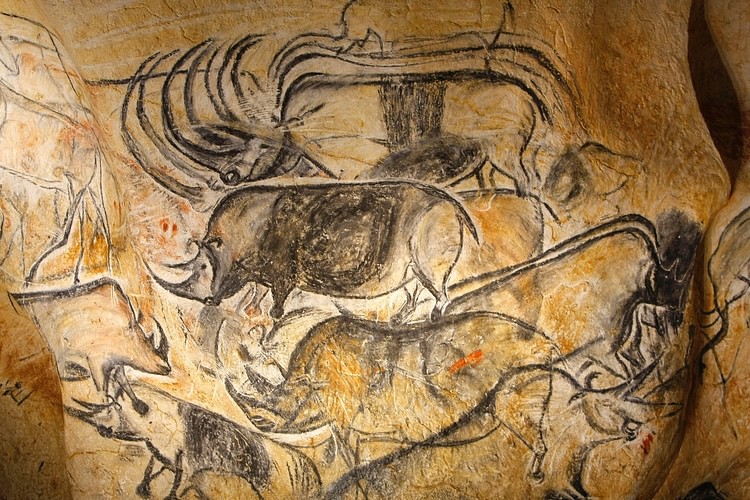
The Chauvet Cave (also known as the Chauvet-Pont-d'Arc Cave) is a Palaeolithic cave situated near Vallon-Pont-d'Arc in the Ardèche region of southern France that houses impeccably preserved, exquisite examples of prehistoric art. Now reliably dated to between c. 33,000 and c. 30,000 years ago, the numerous and diverse animals that dot the interior walls of the cave – both painted and engraved – show such high artistic quality that they were initially thought to have been closer in age to the similarly stunning, but much younger art in caves such as the Lascaux Cave. Its age and artistry have made us reconsider the story of art as well as the capabilities of these humans. The cave has been granted UNESCO World Heritage status.
THE DISCOVERY
On Sunday the 18th of December, 1994 CE, Jean-Marie Chauvet and his two friends Éliette Brunel and Christian Hillaire were following their passion for speleology (the study of caves) and exploring an area on the left bank of the river Ardèche, close to the Pont-d'Arc. A light air flow emanating from a hole alerted them to the possible existence of underground caverns. While making their way through the passages they then discovered some small traces of red ochre, before being blown away by the full magnitude of the hundreds of paintings and engravings.
HUMAN OCCUPATION
The Chauvet Cave was occupied by humans during at least two periods, the first from c. 37,500 years ago to c. 33,500 years ago, and the second from c. 32,000 to c. 27,000 years ago. Around 80% of the registered dates fall around the 32,000 years old mark – which corresponds with the average age of the paintings and engravings and sits snugly in the Aurignacian period.The remaining signs of occupation are from around 27,000 years ago, which ties in with the succeeding Gravettian period.From at least around 21,000 years ago onwards until its rediscovery in 1994 CE, the Chauvet Cave was completely sealed off to visitors due to the entrance having collapsed.

Pont-d'Arc Cavern, Replica of Chauvet Cave
The artists of this cave thus belonged to the Aurignacian culture, the first culture of the Late- or Upper Palaeolithic in Europewhich began when anatomically modern humans first arrived in Europe around 40,000 years ago and lasted until around 28,000 years ago. They were hunter-gatherers whose prey was made up predominantly of reindeer, horses, bison and aurochs, and faced competition from predators such as cave bears and cave lions, panthers and wolves. Aurignacians used a wide range of organic tools, made personal ornaments, figurative art, and even musical instruments, and are thus seen to show the full package of what we call fully modern behaviour.
THERE ARE HUNDREDS OF PAINTINGS & ENGRAVINGS IN THE CHAUVET CAVE, RANGING FROM GEOMETRIC FORMS OF RED DOTS ON THE WALLS, TO HAND PRINTS, TO MORE THAN 420 ANIMAL REPRESENTATIONS.
Hearths have been found within the cave, so it is clear that daily activities of these groups of people took place here, too.Interestingly, the hearths had an additional, non-domestic use – they were also used for producing charcoal, which was part of the artists' tool kit.
The artists of Chauvet Cave had torches at their disposal to cast dim, flickering shadows in the pitch black darkness within the cave. The natural relief of the walls would have been continually highlighted and contrasted, which must have been impressive to witness, especially when combined with the animal shapes used to decorate them. To paint, black paint made from charcoal or manganese dioxide and red paint made from haematite was applied onto the rock surfaces, either by brushes; fingers;using bits of charcoal as pencils; or stump-drawing, which is sticking paint on the wall and then spreading it with your hand or a piece of hide. Paint could also be sprayed onto the walls through tubes, or, for the adventurous, directly from the mouth, across stencils such as hands placed on the wall. Chauvet stands out because here, the walls were often prepared for the imminent paint jobs by scraping them clean first, which really made the paintings pop.
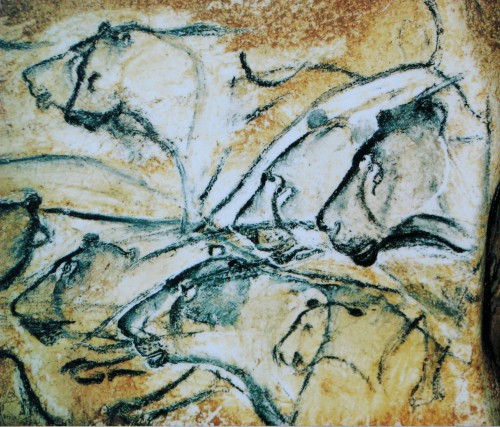
Panel of the Lions (Detail), Chauvet Cave
THE ART
There are hundreds of paintings and engravings in the Chauvet Cave, ranging from geometric forms of red dots on the walls, to hand prints, to more than 420 animal representations. In the majority are animals that were not hunted, such as lions, rhinoceroses, and bears, which is interesting because from the succeeding Gravettian period onward preferences tended to be reversed, with the focus lying on prey animals. Chauvet also stands out for its use of sophisticated techniques such as wall scraping, stump-drawing, and depicting perspective, which are otherwise not as abundantly represented in prehistoric cave art.Although this is a tricky topic, it is thought these Palaeolithic people might have had some sort of shamanistic religion in which the art played a role, perhaps with a dose of hunting magic added to it (where the depicted animals were directly influenced by acting on their images).
THE FIRST PART OF THE CAVE
Some of the first paintings one might bump into after having entered the cave are three cave bears painted in red in a small recess. The artist has cleverly used the relief of the wall to form the shoulders of the biggest bear, as well as stump-drawing the muzzle, the outlines of the head and the forequarters, giving the composition more depth. This first part of the cave, which is characterised by the colour red, is also home to a couple of clusters of large red dots, located in a side chamber, made by dipping the palm of the right hand in liquid red paint and then pushing it against the cave wall. A bit further into the first section of the cave there are some mysterious images, again in red, with geometric bits, that are hard to identify; they could be symbolic signs, or even representations of animals (perhaps a butterfly or a bird with its wings spread?). A large panel of red paintings lies beyond, extending for more than twelve meters, which features mostly handprints, geometric signs, and animals such as lions and rhinos.
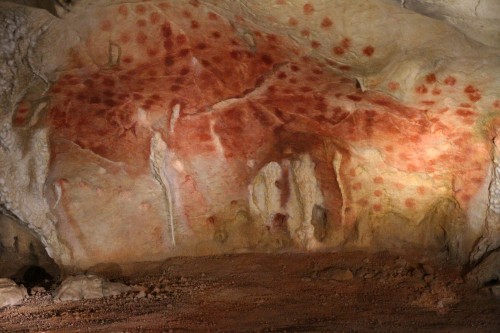
Red Dots Cluster, Chauvet Cave (Replica)
THE SECOND SECTION
A chamber that has no art adorning its walls paves the way into the second section of the cave, where the paintings are now predominantly black rather than red, and engravings step into the limelight, too.
The Hillaire Chamber, situated here, is rife with engravings decorating large hanging rocks; one of them is a remarkable long-eared owl which is shown with its head facing the front while its body is seen from the back, which eternalises the species' cool 180 degree rotation party trick.

Owl engraving, Chauvet Cave (replica)
Further on, more horses jump out, this time drawn in charcoal on the so-called Panel of the Horses. About 20 animals are seen in a unique, naturalistic scene which is rare in Palaeolithic art, and that makes up one of the major pieces of the Chauvet Cave. Taking centre stage are four horses' heads, but the real eye-catchers are two rhinoceroses that stand face to face, horns crossed, confronting each other in just the way male rhinos actually fight in the wild.
A Reindeer Panel and a structure made up of a cave bear skull - decorated with charcoal marks and placed on top of a large limestone block, its hollow eye-sockets peering out into the darkness - further highlight these Palaeolithic humans' versatility.
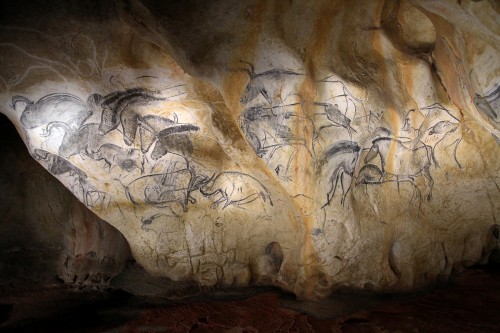
Panel of the Horses, Chauvet Cave (Replica)
EXPLORING THE END CHAMBER
When advancing further into the cave, things just keep getting more spectacular. The end chamber is so richly decorated you hardly know where to look. The first standout piece is the Panel of the Rhinos, drawn with charcoal on rock, featuring nine lions, one reindeer, and a staggering 17 rhinos (who are otherwise very rare in Palaeolithic wall art). The composition has a spatial perspective to it, achieved through leaving gaps in strategic places and decreasing the horn sizes of the rhinos towards the back.
To the right of the central recess, the incredible Panel of the Lions makes up another unique scene in Palaeolithic art; the main scene shows a pride of 16 lions (indicated mostly by just their heads) chasing a group of seven bison. The lions' tense expressions, their poses, and the fact that male lions have joined the females – which happens in nature – leaves us with a snapshot of a hunt in progress. The techniques set this piece apart even further; a scraped surface; shading achieved by stump-drawing; areas left blank to create depth; and enhanced outlines by scraping all serve to make the animals almost leap from the wall.
Some more mysterious shapes than these easily identifiable animals are also present in the end chamber, though. The Panel of the Sorcerer has both black drawings and engravings, and features animals such as lions, a horse, two mammoths and a musk ox, but also an odd shape known as the 'Sorcerer'. It seems to be a composite creature made up of a woman's lower body crowned with the upper body and horned head of a black bison. The last few animals in this chamber are a red rhinoceros, a sketchy rhinoceros, and a mammoth (drawn in charcoal and engraved).
THE CAVE TODAY
Taking the harsh lesson of the Lascaux Cave to heart, which was heavily damaged by the carbon dioxide produced by its countless visitors, the Chauvet Cave is sealed off to the public. It continues to be studied by an interdisciplinary team, originally led by Jean Clottes, and since 2001 CE by Jean-Michel Geneste. A watchful eye is kept out for any alarming signs. To soothe the frantic interests of people fascinated by our artistic ancestors - again following Lascaux' example - a replica (known as the Pont-d'Arc Cavern) has been built close to the original cave.
Chavin Civilization › Origins
Definition and Origins
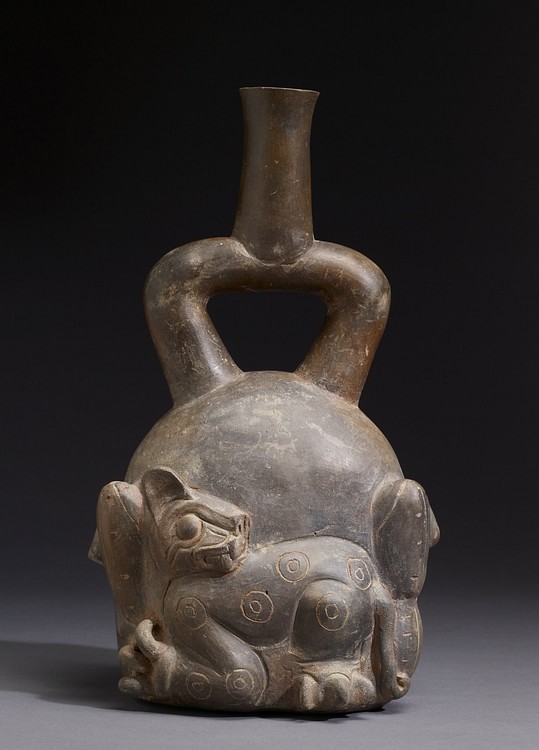
The Chavin civilization flourished between 900 and 200 BCE in the northern and central Andes and was one the earliest pre- Inca cultures. The Chavin religious centre Chavin de Huantar became an important Andean pilgrimage site, and Chavin art was equally influential both with contemporary and later cultures from the Paracas to the Incas, helping to spread Chavin imagery and ideas and establish the first universal Andean belief system.
CHAVIN RELIGION
One of the most important Chavin gods was the Staff Deity, who is the most likely subject for the famous central figure on the Gateway of the Sun at Tiwanaku. Forerunner of the Andean creator god Viracocha, the Staff Deity was associated with agricultural fertility and usually holds a staff in each hand but is also represented in a statue from the New Temple at the Chavin cult site of Chavin de Huantar (see below). This half-metre figure represents male and female duality with one hand holding a spondylus shell and the other a strombus shell. Another celebrated representation from the same site is the Raimondi Stela, a two-metre high granite slab with the god incised in low relief as a non-gender specific figure with clawed feet, talons, and fangs in an image which can be read in two directions. A second important Chavin deity was the fanged jaguar god, also a popular subject in Chavin art.
CHAVIN RELIGIOUS CEREMONY INVOLVED MULTI-SENSORY SPECTACLES WHICH INCLUDED BLOOD-LETTING AND SACRIFICIAL RITUALS.
Chavin religious ceremony involved multi-sensory spectacles which included blood-letting and sacrificial rituals which could be performed in public spaces accommodating up to 1,500 people or in the more restricted and exclusive environment of complex temple interiors. An important feature of the cult was a priesthood of shamans who would put themselves in trances via hallucinatory plants, such as coca leaves and certain types of cacti and mushrooms. An added aura of religious mystery was achieved with the burning of incense, priests suddenly appearing atop the temples via secret internal staircases, and a cacophony of musical sounds from singers and shell trumpets.
CHAVIN DE HUANTAR
The most important Chavin religious site was Chavin de Huantar in the Mosna Valley, which was in use for over five centuries and became a pilgrimage site famed throughout the Andean region. The site is significantly placed at the meeting point of two rivers - a typical Andean tradition - the Mosna and Wacheksa. Ancient landslides left fertile terraces, and the proximity of many springs and an ample and varied supply of stone for monumental building projects ensured the growth of the site.
At its peak the centre had a population of 2,000-3,000 and covered around 100 acres. The Old Temple dates from c. 750 BCE and is actually a complex of buildings which together form a U-shape. In the centre, two staircases descend to a circular sunken court. The walls of the buildings are lined with square and rectangular stone slabs which carry images of transformational, shamanic creatures, carved in low relief. The figures mix human features with jaguar fangs and claws and they wear snake headdresses symbolising spiritual vision.

Chavin Civilization Map
The 4.5 metre tall Lanzón monolith takes the form of a traditional Andean foot plough and stands deep within the labyrinthine interior of the Old Temple. It shows a supernatural creature with tusks and claws which is decorated with snakes. The creature points down with one hand and up with the other, perhaps indicative of its rulership of the earthly and heavenly realms. It is thought that this monolith was perhaps the site of an ancient oracle which gave answers to the demands of pilgrims who in turn left offerings of gold, obsidian, shells, and ceramics. There are also many stone channels in the temple interior through which water would have run under pressure thus creating an impressive noise in the confined inner chambers and an evocative accompaniment to the oracle's declarations.
The most striking feature of the New Temple (from c. 500 BCE), which was actually an extension of the Old Temple complex, is the 100 surviving stone heads which once protruded from the exterior walls. These form a transformational series and progressively change from human to jaguar form. The temple in its new form measured 100 metres in length and reached a height of 16 metres with three stories. Its Black and White Portal entrance is flanked on either side by a single column ; one carries an image of an eagle, the other a hawk representing the female and male respectively in a typical Chavin example of duality. The New Temple also contains the 2.5 metre tall Tello Obelisk which shows two caymans and snakes and may represent the creation myth. Opposite the temple a large square 50-metre-sided sunken court was constructed for ceremonial purposes, a feature which would become standard in many subsequent Andean religious sites.
Other more modest buildings at Chavin de Huantar, which often use distinctive conical-shaped adobe bricks, indicate that there was a large number of permanent residents, a social hierarchy, and centres of craft specialization. The site and the Chavin culture in general entered into decline sometime in the 3rd century CE for reasons which remain unclear but that are probably related to several years of drought and earthquakes and the inevitable social upheaval caused by such stress. There is no archaeological evidence of a Chavin military force or of specific regional conquests. The political structures of the Chavin, then, unfortunately remain mysterious, but they did create a lasting artistic legacy which would influence almost all subsequent Andean civilizations.

Chavin Stone Tenon Head
CHAVIN ART
Chavin art is full of imagery of felines (especially jaguars), snakes, and raptors, as well as supernatural beings, often with ferocious-looking fangs. Creatures are often transformational - presented in two states at once - and designed to both confuse and surprise. Images are also very often anatropic - they may be viewed from different directions. As the art historian RR Stone summarises:
A strong perceptual effect, certainly calculated by Chavin artists, inspires confusion, surprise, fear, and awe through the use of dynamic, shifting images that contain varying readings depending on the direction in which they are approached. (37)
It is also noteworthy that many of the animals in Chavin imagery are from the distant lowland jungles and thus illustrate the far-reaching influence of Chavin culture, a point further confirmed by the presence at Chavin de Huantar of votive offerings from cultures hundreds of kilometres distant. The Staff Deity was another popular subject in Chavin sculpture, ceramics, and textiles. The painted cotton textiles of the Chavin are, in fact, the earliest such examples from any Andean culture and take the form of hangings, belts, and clothes.
Typical Chavin pottery is high quality and thin-walled, usually a polished red, black, or brown. The most common shape is the stirrup-spouted bulbous vessel, often with polished raised designs depicting imagery from Chavin religion. Vessels could also be anthropomorphic, typically of jaguars, seated humans, and fruits and plants. Shells were a popular form of jewellery amongst the Chavin elite and could also be carved into trumpets for use in religious ceremonies. Fine wooden bowls survive which are exquisitely inlaid with spondylus shell and mother-of-pearl, as well as turquoise. Finally, the Chavin were skilled metal workers and created objects - especially cylinder crowns, masks, pectorals, and jewellery - in sheet gold using soldering and repoussé techniques to rival any other Andean culture in their imagination and execution.
Cunda: the Beginnings of Lay Buddhism › Origins
Ancient Civilizations
The frail Buddha Shakyamuni, known as Gautama Buddha and the Historical Buddha, had reached the end of his physical life and long teaching career. He and his close disciples decided on his final resting place under the twin sala trees in Kushinagar, the republic of Malla in North Eastern Ancient India. There he lay on his side surrounded by many dignitaries and enlightened monks who had gathered to say farewell to him, (c. 563 or 480 BCE). Among them, there was a deeply devoted lay follower named Cunda (Chunda). He was the son of a blacksmith from the nearby area of Kushinagara castle who had come of his own accord to pay his respects to the great Buddha, bringing with him 15 of his friends.
To show his devotion, Chunda had discarded his daily work clothes and put on a simple robe, bearing his right shoulder in the traditional way of monastics. He knelt on his right knee and bowed at the feet of the Buddha. He then made a speech confidently and sincerely which was to change the future course of Buddhism.
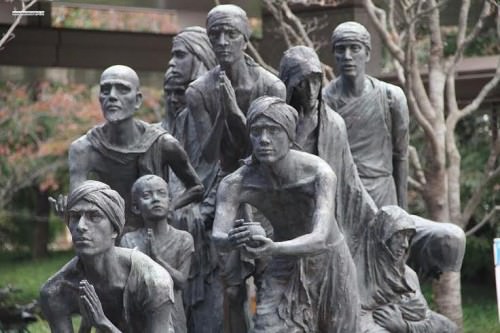
Cunda & Friends
As all those attending had done, Chunda implored the Buddha to accept the simple customary offerings of homemade food he and his friends had brought. All the distinguished members of the congregation had already offered luxurious gifts of precious commodities like livestock and gold, but the Buddha had refused to accept everything until this point. Suddenly, to everyone's surprise, Chunda's modest offerings were accepted and he proceeded to eloquently express his deep sadness of himself and his 15 friends at the prospect of losing the Buddha. He hoped that the simple food would prepare him for entering Parinirvana, the highest state of the ceasing of all craving, and that all sentient beings would not suffer from spiritual poverty after his decease.
In ancient India, and to a certain extent there today, the rigid caste system rejected people such as Chunda because he did not fit into any of the four main castes: He was not a clergyman or scholar, not of the nobility or a warrior, not a merchant or farmer, or a general labourer or servant. But he had confidence that all humans, despite their caste imposed at birth, were equal, and that when the Buddha left them, they would all be equally spiritually destitute. He said:
O World Honoured One! My situation is like that of anyone among the four castes who, because of poverty, has to leave his country to find work and then buy domesticated cattle and fertile fields. After removing the stones and weeds and tilling his land, he has only to wait for the rain to fall from the sky. (Chapter 2, Mahaparinirvana Sutra )
His words displayed great wisdom despite his lack of formal education or spiritual training. He knew that all living beings needed simply the rain of the Dharma to make them spiritually fertile, and that the Buddha, the truly awakened one, the Tathagata, could bring such rain into the human world of suffering ( samsara ). The Buddha was delighted and immediately conferred eternal life and connected him to the ever-presence ( Skt.; dharmakaya ). In other words, he was enlightened on the spot.
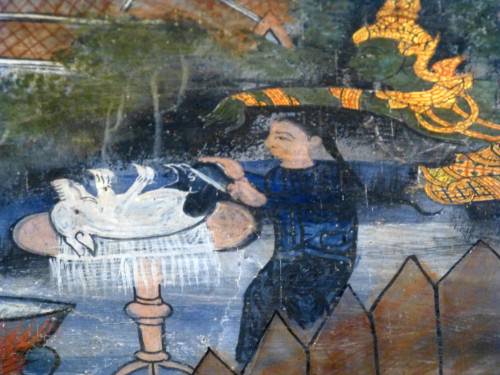
Cunda Preparing the Last Meal for the Buddha
During his ministry the Buddha had insisted that his disciples should leave their ordinary life and become monastic practitioners, learning strict moral discipline ( Vinaya ) and upholding monastic rules. The assembled disciples who had reached the pinnacle of all spiritual training were looking on as Chunda, a lay person and an 'untouchable' – a person outside the caste system - became immediately enlightened with no training and therefore supposedly little virtue. Chunda became the exception that was to be a crucial part of the Buddha's last will and testament as he moved back to the spiritual source.
THE UNPRECEDENTED ENLIGHTENING OF CHUNDA, A LAY PERSON AND HOUSEHOLDER, WAS TO OPEN THE PATH FOR ALL BEINGS, NO MATTER WHAT THEIR CASTE.
There were two ways in which this moment in the history of Buddhism brought fundamental changes to the aspirations of Buddhists. Firstly, this unprecedented enlightening of Chunda, a lay person and householder was to open the path for all beings, no matter what their caste, whether lay or clerical, to aspire to reach Nirvana (or enlightenment). It is easy to imagine just how radically this changed the course of Mahayana Buddhism because now anyone could become enlightened and many lay Buddhist orders emerged later.
Secondly, Chunda became enlightened within his own lifetime as a relatively young man. He did not have to work hard to accrue merit and virtue in order to become enlightened in a future lifetime, which was the prevailing Brahmin belief at the time.The Buddha's acceptance of humble Chunda's offerings was symbolic of the fact that all sentient beings are endowed with Buddha Nature, and that when the rain of Dharma waters the seeds of Buddha Nature, they will ripen, cutting away all negative karma and human suffering. By bringing so many of his friends in a sincere gesture of reverence to the Buddha and by having the confidence to make his offering in front of all the dignitaries and esteemed disciples, he had exhibited the spirit of a Buddha, without training or privilege.
In appreciation of the Buddha's acceptance of his humble offerings, Chunda said,
It is hard to be born a human being, and harder still to encounter a Buddha. It would be like a blind sea turtle encountering a floating log with a hole in it and poking its head through. ( The Great Parinirvana Sutra )
This comment prompted the Buddha to leave his final instructions before shifting into Parinirvana. His final teachings known as the Dharmakaya focused on impermanence and detachment followed. He left them in place of his physical body, assuring the grieving congregation that he would always be with them embodied in the last teachings and that these final teachings would exist for all eternity because they were indestructible.
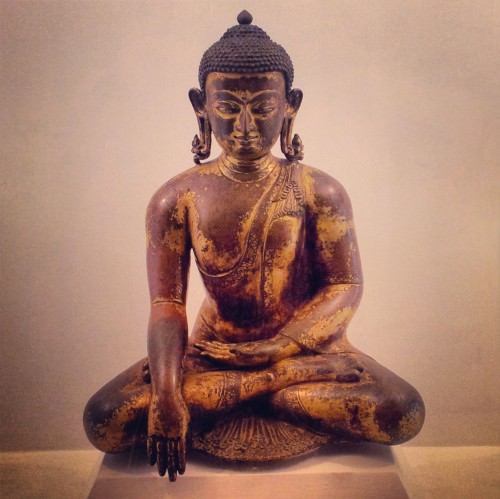
Siddhartha Gautama, the Historical Buddha
Chunda is also reputed to have described the rareness of meeting a Buddha in the Sala grove as follows:
An udambara (a flower said to bloom once every 3000 years) can rarely be seen, and so is it to encounter a Buddha…who can nurture the faith of all sentient beings and…extinguish the suffering of death and rebirth. ( The Heart, Diamond and the Lotus Sutra )
A recent sculpture of Chunda in the Sala Grove with his 15 friends executed by a modern Japanese sculptor is an inspiration for Japanese Buddhists of Shinnyo Buddhism whose principal belief is that all beings are capable of polishing their Buddha Nature and reaching Nirvana.
Chunda's deep humility and sincere heart radiated out beyond that of the advanced practitioners and enlightened who had perhaps become arrogant or complacent. This indicates that practising as a true Buddhist of the heart is not about worldly success and reputation, but about humility, sincerity, and simple but total belief in the power of loving goodness and pure faith in the world. The character of Chunda marks the beginning not only of lay Buddhism but also a prevailing feature of the Mahayanas of Buddhism (2nd century CE onwards), the Bodhisattva who achieves enlightenment for the sake of all other beings and vows to postpone his own enlightenment until universal enlightenment is reached.
LICENSE
Article based on information obtained from these sources:with permission from the Website Ancient History Encyclopedia
Content is available under License Creative Commons: Attribution-NonCommercial-ShareAlike 3.0 Unported. CC-BY-NC-SA License